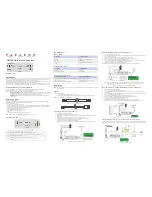
Large-scale Decoder & Sound Decoder MX695, MX696, MX697, MX699 Page 21
CV
Designation
Range
Default Description
Bit 7 = 0: unregulated DC operation
= 1: regulated DC operation
,
#29
Base Configuration
0 - 3
0
Bit 0
– Train direction:
0 = normal, 1 = reversed
Bit 1 - Number of speed steps:
0 = 14, 1 = 28
Bit 2
– DC operation (analog mode)
0 = disabled 1 = enabled
Bit 3 - RailCom (
“
bi-
directional communication“)
0 = deactivated 1
=
activated
Bit 4
– Individual speed table
0 = off, CV #2, 5 and 6 are active.
1 = on, according to CV ‘s #67 – 9494
Bit 5 - Decoder address selection:
0 = short address as per CV #1
1 = long address as per CV #17+18
Note: Actual decoder settings may differ from the default values if a sound project is on the decoder; in par-
ticular, the motor regulation (CV #14, Bit 7) is often enabled. The regulation only works well with power
packs that apply “clean” DC voltage (i.e. with an LGB 50 080); otherwise it is better to turn the motor regula-
tion off.
5.6 Motor
control and regulation
The Speed Curve
There are two ways of programming the speed curve:
CV #29, Bit 4
= 0
: three-step curve (defined by
3 CV’s)
... = 1
: 28-step curve (defined by
28 CV’s)
Three-step curve: the lowest, highest and medium speed is defined by the Configuration Vari-
ables #2 (Vstart), #5 (Vhigh) and #6 (Vmid). This is a simple way to quickly establish a speed
range and its curvature.
The three-step curve is usually sufficient.
28
– step curve (a.k.a. free programmable speed curve): with the help of CV’s #67 - 94, all 28
external speed steps can be freely
assigned to the 128 internal speed steps. These 28 CV’s
apply to all speed step modes (14, 28 and 128). If 128 external speed steps are used, the de-
coder adds the missing intermediate values by interpolation.
CV
Designation
Range
Default Description
#2
Vstart
(Lowest speed)
three step curve if
CV #29, Bit 4 = 0
1 - 255
1
Internal speed step (1 … 255) applied as
lowest
external speed step (= speed step 1)
(applies to 14, 28, or 128 speed step modes)
= 1: lowest possible speed
#5
Vhigh
(Maximum speed)
three step curve if
CV #29, Bit 4 = 0
0 - 255
1
equivalent
255
Internal speed step (1 … 255) applied as
highest
external speed step (14, 25 or 128,
depending on the speed step mode selected in
CV # 29, Bit 1)
= 1 (same as 255): fastest top speed possible.
#6
Vmid
(Medium speed)
1,
¼ to ½
of the
value in
CV #5
1
(= @ 1/3
of
top speed)
Internal speed step (1 … 255) applied as
medium
external speed step (that is, speed step 7,
14 or 63 depending on the speed step mode selected
in CV #29, Bit 1)
”1" = default curve (Medium speed is set to one third
of top speed. I.e., if CV #5 = 255 the curve is the
same as if CV #6 would be programmed to 85).
The speed curve resulting from CV #2, 5 and 6 is au-
tomatically smoothed out.
#29
Basic Configuration
Configuration data
0 - 63
14 =
0000 1110
Bit 2 = 0
(three step
speed curve)
Bit 0 - Train direction:
0 = normal, 1 = reversed
Bit 1 - Number of speed steps:
0 = 14, 1 = 28/128
Bit 2 - DC operation (analog):
0 = disabled 1 = enabled
Bit 3 -
RailCom (“bidirectional communication“)
0 = deactivated 1 = activated
Bit 4 - Individual speed table:
0 = off, CV # 2, 5 and 6 are active.
1 = on, according to CV ‘s # 67 – 94
Bit 5 - Decoder address:
0 = primary address as per CV #1
1 = ext. address as per CV #17+18
#67
.…..
#94
Individual Speed
Curve,
if CV #29, Bit 4 = 1
0 - 255
*)
User programmable speed table.
Each CV corresponds to one of the 28 external speed
steps that can be “mapped” to internal steps (1 – 255).
*) The 28-point default curve is also bent in the lower
speed range.
#66
#95
Directional Speed
Trimming
0 - 255
0 - 255
0
0
Speed step multiplication
by “n/128” (n = trim value)
for forward (CV # 66) or reverse direction (# 95).
Reference Voltage for motor control
CV # 57
specifies the voltage, which is used as a base for motor regulation. For example: if
14V is selected (CV value: 140) the decoder tries to send the exact fraction of this voltage,
given by the speed regulator position, to the motor regardless of the voltage level at the track.
As a result the speed remains constant even if the track voltage fluctuates, provided the track
voltage (more precisely, the rectified and processed voltage inside the decoder, which is about
2V lower) doesn’t fall below the absolute reference voltage.
Summary of Contents for MX695
Page 6: ...Page 6 Large scale Decoder Sound Decoder MX695 6 7 9 ...
Page 7: ...Large scale Decoder Sound Decoder MX695 MX696 MX697 MX699 Page 7 MX697 ...
Page 8: ...Page 8 Large scale Decoder Sound Decoder MX695 6 7 9 ...
Page 14: ...Page 14 Large scale Decoder Sound Decoder MX695 6 7 9 ...
Page 15: ...Large scale Decoder Sound Decoder MX695 MX696 MX697 MX699 Page 15 ...
















































